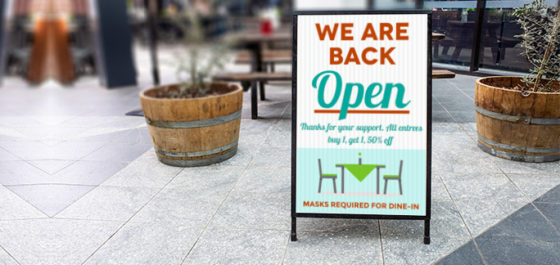You’ve managed to propel your business this far through COVID-19. Your resiliency and business savviness have enabled you to re-open, and again get customers to begin coming through your doors – perhaps not at the same pace as last year at this time, but they’re coming in and buying just the same. You are constantly searching for small business tips for COVID-19.
However, it sometimes still feels like you’re treading water. And you see that businesses in some states – and maybe in your own state – are in danger of having restrictions placed back on them to counter a resurgent COVID-19.
You’re not alone, of course – it’s an all-too-common feeling in our continued journey through this pandemic. Currently, we’re all anxiously awaiting word on a possible COVID-19 vaccine, as well as a second federally backed stimulus package to help alleviate the economic fallout from the virus.
Meanwhile, you want to determine what steps you can take to push your company forward. And, beyond your immediate concerns, you’d also like to set some things in motion that might help ensure your business doesn’t regress in the weeks and months ahead.
To help, we’ve assembled the following “menu” of considerations, actions, and courses of actions you might want to consider for your operation.
Financial Considerations

Are there actions you can take that will have a direct impact on your company’s finances? In the early days of the pandemic, of course, nearly all companies had to take some drastic steps to immediately protect themselves from further economic bloodshed – from temporary employee furloughs to salary reductions, staff reductions, and even more drastic measures. Some companies were able to take advantage of the initial federally funded COVID-19 packages and secure a loan.
Consider these financial options:
New loans/grants/financial support: Although the deadline for a federally backed COVID-related loan through the U.S. Small Business Administration (SBA) passed in early August, some states still have federal CARES Act relief funds available to small businesses – typically, these funds can be utilized for any unexpected expenditures incurred by the COVID-19 pandemic after a certain date. Check also with your local and regional governmental bodies. The U.S. Chamber of Commerce Live Blog is a good resource to stay up-to-date on COVID-19 federal programs, as is the SBA; and the Local Initiatives Support Corporation (LISC) has assembled an excellent state-by-state list of resources for small businesses.
Renegotiate current loans: Check with your lender to see if you can renegotiate any current loans or leases.
Negotiate on new purchases: If you’re about to make a major purchase, don’t hesitate to negotiate to see if you can get a better deal on a new piece of equipment or technology. Whether the new purchase is out of necessity or you believe it will enable you to be more efficient (see below), be sure you’re getting the best price, options, lease arrangement, warranty, and more.
Investigate bartering: The age-old system of bartering – trading services for services or products – has made a bit of a comeback during COVID-19. As we learned from our recent discussion with a customer in Pennsylvania, bartering can enable you to trade for things you might normally spend cash on, including office supplies, landscaping, vehicle fleet repair, facilities maintenance, and more.
Evaluate your current contractors (and consider others): Now might be a good time to re-evaluate your current contractors to ensure you’re getting the best service for your money. If you have some down time, explore other contractors to see if they might be able to provide better service. Don’t, however, simply look for the least-expensive contactor – keep in mind that customer service and goodwill can often translate to your bottom line.
Assess your facilities: If you find yourself with extra space in your facility that’s not being utilized, determine if sub-leasing the space to another company (perhaps one experiencing your same challenges) makes sense. Yes, this will then put someone at your company in a “property manager” role, but if you believe you won’t be utilizing the space anytime soon, why not explore this option? And, of course, if you realize you have a larger footprint than you likely will need in the future, now may the time to check out a possible smaller space. Or perhaps now is the time to consider looking for a superior space – one that will put you in good position once the pandemic is behind us: With various retail chains canceling their leases, the time could be ripe for you to look into a new brick-and-mortar home.
Operational Courses of Action

The day-to-day operations of your business have likely already changed due to COVID-19, but there may be more you can do to help ensure your company continues its way forward.
Adjustments to your business model: If you haven’t already done so, evaluate if refining your basic business model will help your company. Restaurants, for example, re-focused their efforts on meals to go and began offering free delivery; and various manufacturers were able to switch some of their manufacturing to creating cashier shields for retail and PPE.
Pivot in a hurry: Be willing to pivot and to do so quickly – away from bad scenarios and toward opportunities. Grocers and many retailers, for instance, didn’t hesitate in moving from customers buying in-store to buying online for curbside pickup and/or delivery; they realized they had to adapt and do so quickly in order to survive.
Analyze your efficiencies: Are there steps you can take to successfully operate your business with less wasted time, effort, or resources? Step back and see if you can recognize inefficiencies in your current operational procedures and adjust these. For instance, on your primary delivery day from your corporate warehouse, perhaps you can improve on your speed of unloading and then stocking incoming merchandise (hence getting goods more quickly in front of your customers)? Or if you’re aware that some new merchandise is on its way to your store – a new line of fall jackets that will be promoted, for example – can you plan for this ahead of time by clearing floor and/or wall space; again, getting merchandise out of the stock room and onto the sales floor that much quicker.
Evaluate your current technology: Now is a good time to take a close look at the technology you’re currently using – is it up to par? Consider replacing your older, perhaps outdated technology with something more modern and efficient. Alternately, perhaps you’ve over-invested in certain technology – does it make sense to consider divesting yourself of a piece of machinery that has simply served as a rather large doorstop for the past year or more?
Suppliers as resources: Don’t hesitate to lean on your suppliers, distributors, and dealers. In most cases, these folks are very willing to answer your questions about best practices, serve as an industry resource, and perhaps provide you with an idea or two that will provide an immediate benefit. After all, suppliers and distributors stand to benefit when you succeed (because you’ll then be ordering more products and supplies).
Cross-train your employees: Take advantage of downtime by cross-training your staff so that they have expertise in more than just a single area. This is also a good time to evaluate your overall staff situation – do you have the right staff mix now and going forward? Are you weak in an area you now need to be stronger in – has your COVID-related response necessitated, for instance, that your ratio of in-store help to delivery drivers should change? Consider permanently re-assigning staff to new duties/tasks, or even bringing in new/additional staff if the return on investment might be there.
Make clean and safe an operational priority: We’re assuming that you’re already executing the basics at a minimum: having employees wear face coverings, implementing social-distancing, and performing regular sanitizing and cleaning. Look at stepping up your efforts, however, to ensure employees as well as customers will be protected from the spread of COVID-19. Consider daily health checks for employees; encourage customers to wear face coverings (if they’re not already mandated to do so); have your facility’s ventilation system checked to ensure it’s running properly; determine the need for personal protective equipment. (The Centers for Disease Control has made available a free “Resuming Business Toolkit.”) Don’t forget to let your customers know that you’ve taken these steps to help ensure their well-being.
Marketing & More

Now that your company is back up and running, this is not the time to put your marketing into a state of hibernation. In fact, many would argue, this is the time to ratchet up your marketing efforts if you can do so.
Increase social-media usage: It is, after all, free. Analyze your channels and see what kind of traction you’re getting on each. Are you putting energy into a channel that simply isn’t generating any kind of traffic? If so, determine if it makes sense to concentrate your social-media efforts elsewhere. But, generally, you should be increasing your efforts here – if you aren’t as comfortable using social media as you’d like to be or you’re simply too busy, assign the task to someone else on your staff (you can also assign specific channels to specific staffers if you want to “spread the wealth”).
Ramp up your blog frequency, other content: As with social media, the more you can do here, the greater the chance for a likely payoff. Written blog posts don’t have to be extravagantly long, but nor should they be a couple of sentences. Generally, stick to business-related content (versus something about how your cat just had kittens – unless it’s the store mascot). And just as with family dinner conversations, avoid such topics as politics, religion, sex, and any personal drama.
Market with email: Are you collecting customer emails at your check out/register for follow-up or promotional purposes? Assuming you have email addresses from those opted-in customers, consider starting an ongoing e-mail marketing campaign using a service such as Constant Contact or Mailchimp.
Put it in print: If you have solicited customers’ street addresses, print campaigns are another way to go. Printed flyers and post cards make great mailers, and you might be surprised how receptive Millennials and Zoomers are to print. Other print options to explore include door hangers, brochures, posters, and advertising in local/regional newspapers or publications (if you’re already doing the latter, determine if increasing your frequency would provide you with a better rate).
Sell with signage: Speaking of print, it probably comes as no surprise to you that we’re also going to recommend you take a close look at your current signage and determine if you need something new. Of course, doing so should be a standard component of your marketing plan in any regular year – but in this COVID-19 year, signage can be even more critical to the success of your business.
If you’re a retail operation, you can drive traffic to your store with banners, window decals, and A-frames; inside, utilize foam board signage for point-of-purchase displays and for sales. Restaurants will use a variety of signage for take-out menu boards, window displays, curbside pickup, and outdoor venues. And, of course, office environments need signage for COVID-related messaging, lobbies, meeting/board rooms, bathrooms, and other spaces.
Other Actions to Take

Bolster relationships: This is a good time to be sure you’re maintaining – and strengthening – your business relationships, particularly with companies in your area. Whether you choose to do so via conference call, social media, email, telephone, or in-person, reach out to your network. Share your challenges and your successes; congratulate folks on their endeavors; and don’t hesitate to offer your assistance.
Be transparent: Be even more open than usual with your employees as well as your customers – we’re all in the same boat. With staff, it’s likely better to err on the side of more communication right now, to ensure that everyone is in the know when it comes to where the company stands.
Empathy to employees: Beyond purely communicating to employees, let them know that you care – and devise ways to show this. This can range from small tokens of appreciation (e.g., gift cards, t-shirts, baseball caps) and personal thank-you cards to Friday pizza days and additional vacation/PTO. Take the time to have one-on-one chats with each staffer, even if it’s just over a cup of coffee at the food truck or via a phone call.
Weathering the COVID-19 Storm posted first on https://anaheimsignsorangecounty.blogspot.com
No comments:
Post a Comment